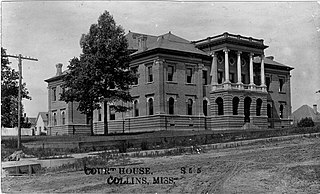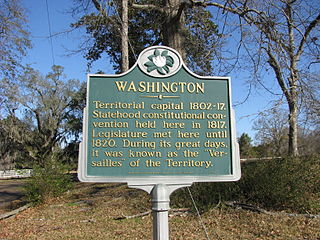
Jefferson Davis County is a county located in the U.S. state of Mississippi. As of the 2020 census, the population was 11,321. Its county seat is Prentiss. The county is named after Mississippi Senator and Confederate President Jefferson Davis. The county was carved out of Covington and Lawrence counties in March 1906. Governor James K. Vardaman signed the bill creating the county on May 9, 1906.

Covington County is a county located in the U.S. state of Mississippi. As of the 2020 census, the population was 18,340. Its county seat is Collins. The county is named for U.S. Army officer and Congressman Leonard Covington.

Prentiss is a town in Jefferson Davis County, Mississippi. The population was 1,081 at the 2010 census, down from 1,158 at the 2000 census. It is the county seat.

Washington is an unincorporated community in Adams County, Mississippi, United States. Located along the lower Mississippi, 6 miles (9.7 km) east of Natchez, it was the second and longest-serving capital of the Mississippi Territory.

Mount Carmel Junction and Mount Carmel are unincorporated communities located 12 miles (19 km) east of Zion National Park and 17 miles (27 km) north of Kanab in Kane County, Utah, United States. They lie in close proximity to the Coral Pink Sand Dunes State Park.
These congregations are affiliated with one of the five associations comprising the Heartland Conference of the United Church of Christ. They are listed in order of association.
Mount Zion is a hill in Jerusalem.
Lancaster is an unincorporated community in Lancaster Township, Jefferson County, Indiana.

Mt. Zion Memorial Church, also known as Mt. Zion Methodist Episcopal Church or Mt. Zion United Methodist Church, is a historic Methodist Episcopal church located at Princess Anne, Somerset County, Maryland. It is a single-story asymmetrically planned "T"-shaped timber-frame structure constructed in 1887 and remodeled in 1916. It features a three-story entrance tower with an open belfry. It served the African-American community along Polks Road in northern Somerset County.
A Mississippi Landmark is a building officially nominated by the Mississippi Department of Archives and History and approved by each county's chancery clerk. The Mississippi Landmark designation is the highest form of recognition bestowed on properties by the state of Mississippi, and designated properties are protected from changes that may alter the property's historic character. Currently there are 890 designated landmarks in the state. Mississippi Landmarks are spread out between eighty-one of Mississippi's eighty-two counties; only Issaquena County has no such landmarks.
Carpenter is a small unincorporated community in Copiah County, Mississippi, United States. A former railroad town located seven miles from Utica in the extreme northwestern corner of the county, Carpenter was named for Joseph Neibert Carpenter, president of the Natchez, Jackson and Columbia Railroad.

Bethel African Methodist Episcopal Church is a historic African Methodist Episcopal Church in Springtown, New Jersey, United States. The church was part of two free negro communities, Othello and Springtown, established by local Quaker families. The congregation was established in 1810 in Greenwich Township as the African Methodist Society and joined the African Methodist Episcopal Church in 1817. A previous church building was burned down in the 1830s in an arson incident and the current structure was built between 1838 and 1841.

Mount Carmel A.M.E. Zion Church & Campground is a historic African Methodist Episcopal Zion camp meeting grounds in Heath Springs, South Carolina, Lancaster County, South Carolina. It was established in 1866 and consists of a complex of approximately 55 small "cabins" or "tents" and the brick church of Mt. Carmel A.M.E. Zion Church is located in the general form of a rectangle. Mount Carmel A.M.E Zion Church Campmeeting starts every year on the first Wednesday in September, and last for 4–5 days. An "arbor," or open-air structure, is located in the center of the complex, where music, gospel singing, praise and worship, preaching and teachings are held. People come to worship, fellowship, network, and eat food from as far as New York City, NY to Orlando, FL. There is also a section on the grounds for vendors. The majority of the cabins are small frame, some are two story cabins for larger families made from concrete block and wooden structures. Also on the property is the church cemetery.

Thomas Spottswood Hinde was an American newspaper editor, opponent of slavery, author, historian, real estate investor, Methodist minister and a founder of the city of Mount Carmel, Illinois. Members of the Hinde family were prominent in Virginia, Kentucky, Ohio, and Illinois. His sons Charles T. Hinde became a shipping magnate and Edmund C. Hinde an adventurer. He was the father-in-law of judge Charles H. Constable.
Carson is an unincorporated community in Jefferson Davis County, Mississippi, United States. Carson is located on Mississippi Highway 42, 6 miles (9.7 km) southeast of Prentiss. Carson has a post office with ZIP code 39427.

Binnsville is a ghost town in Kemper County, Mississippi, United States.

Old Greenville is a ghost town in Jefferson County, Mississippi, United States. The town was located along the old Natchez Trace and was once the largest town along the Trace. Nothing exists at the site today except the town's cemetery.












